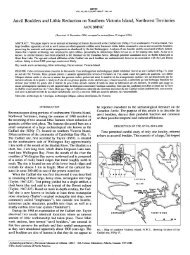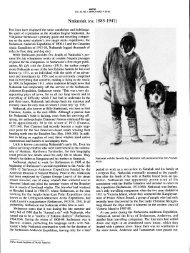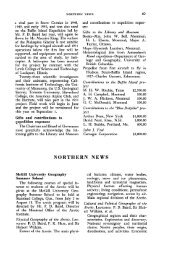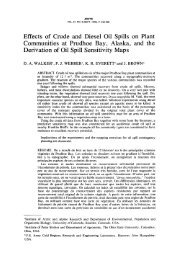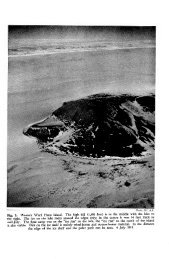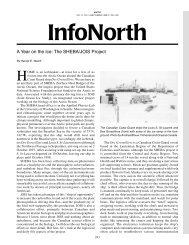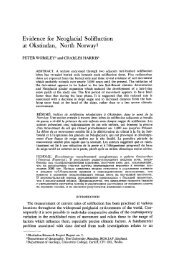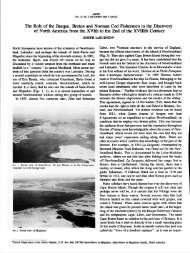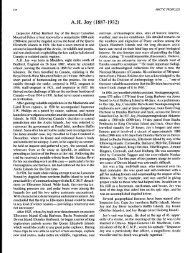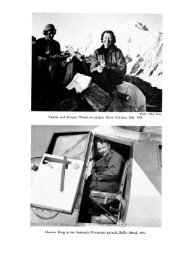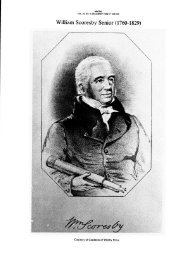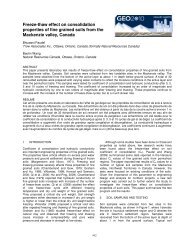You also want an ePaper? Increase the reach of your titles
YUMPU automatically turns print PDFs into web optimized ePapers that Google loves.
100 ARCTIC PROFILES<br />
<strong>Samuel</strong> <strong>Hearne</strong> (<strong>1745</strong>-<strong>1792</strong>)<br />
<strong>Samuel</strong> <strong>Hearne</strong> was a contradictory and controversial rant a biography and too inept to deserve respect. The opposite<br />
character. He was a gentle man who avoided violence when he evaluation places him high on the roster of giants who made<br />
could, but lashed out when it was necessary to achieve his the Age of Discovery the most adventuresome era in history.<br />
goal; he loved good clothes and food, but could go long<br />
<strong>Hearne</strong> was born in <strong>1745</strong> in London. He was an indifferent<br />
periods without either; he drank almost no alcohol, but on his schdboy and at the age of eleven was in the Royal Navy<br />
retirement joined the exclusive Bucks Club in London whose under the command of Admiral <strong>Samuel</strong> Hood. He saw action<br />
sole purpose was to get roaring drunk and go rampaging during the Seven Years War but left the Navy and, in 1766,<br />
through nighttime streets. As an historical figure, commen- became an employee of the Hudson’s Bay Company, which<br />
tators then, and historians now, have never agreed on what sent him to Fort Prince of Wales at the mouth of the Churchill<br />
manner of man he was or on the significance of his work. To River,<br />
one school he was an arrant coward, too unimportant to war- The charter of the Hudson’s &y Company gave it virtual
. a I;. -<br />
.,<br />
...-.r^i:.>:<br />
ARCTIC PROFILES<br />
101<br />
sovereignty over all the lands draining into the west shores of<br />
Hudson Bay, but it provided also that the Company explore,<br />
establish posts in the interior, and search for the Northwest<br />
Passage, or Strait of Anian as it was generally termed on non-<br />
English charts. No one knows how the concept of a waterway<br />
through North America came to be, but from Juan de la Cosa,<br />
1500, to Jonathan Carver, 1788, cartographers depicted it on<br />
their maps. The nation that discovered and controlled it would<br />
break the Spanish hold on Pacific-Orient trade and open a<br />
shorter and more profitable route ta the Far East. Cartier,<br />
Frobisher, Gilbert, Davis, Hudson, Munk, and many others<br />
had sought it. But it was left for <strong>Samuel</strong> <strong>Hearne</strong> to prove their<br />
labours had been in vain.<br />
During its first century the Company had made no determined<br />
attempt to penetrate the interior and only the most halfhearted<br />
excursions were sent to seek Anian. By the 1730s,<br />
however, significant opposition to Company sovereignty and<br />
its implementation of its charter obligations had arisen in both<br />
England and America. Arthur Dobbs, Surveyor-General of<br />
Ireland, initiated a twenty-year struggle to force the Company<br />
to meet its charter terms. His challenges generated enough interest<br />
to induce the House of Parliament to offer a prize of<br />
f20,OOO for the discovery of a strait.<br />
By 1769 it had been demonstrated that no such passage existed<br />
between the Churchill River and the Gulf of Mexico, and<br />
by then, too, <strong>Samuel</strong> <strong>Hearne</strong> had become dissatisfied. He<br />
disliked routine Company work, he detested Moses Norton,<br />
Chief Factor at Fort Prince of Wales, and as yet there had been<br />
no opportunity to “make a name” for himself, as he phrased<br />
it.<br />
Rumours of extensive inland copper deposits had often come<br />
to the Churchill, but nothing had been done about them.<br />
<strong>Hearne</strong> saw his chance. He applied for and was granted permission<br />
to lead an expedition into the North, accompanied by<br />
two white men and certain Indians, to “promote . . . our trade,<br />
as well as for the discovery of a North West Passage, Copper<br />
Mines, etc.. . . ” The attempt was a humiliating failure. Two<br />
hundred miles northwest of the fort the Indians robbed the<br />
white men and left them to reach safety as best they could.<br />
<strong>Hearne</strong> began again in February 1770, with only native<br />
companions. He got three hundred miles inland and four hundred<br />
miles north of the Churchill before he was robbed. He<br />
turned toward home. Nevertheless, it was the farthest north<br />
any European had yet explored inland North America.<br />
On the return to the Churchill, <strong>Hearne</strong> met Matonabbee, an<br />
important Chipewyan chief, who offered to guide a third attempt<br />
toward the Arctic. Norton agreed and between<br />
December 1770 and June 1772 <strong>Hearne</strong> - again the only white<br />
man - headed an expedition across the Barren Grounds. In<br />
our day of elaborate preparations for even a minor venture it is<br />
difficult to appreciate <strong>Hearne</strong>’s courage. He proposed to, and<br />
did, walk overland to the North without any civilized supplies<br />
beyond the first few miles. Starvation and death in arctic<br />
storms were constant attendants, but in the end he was at the<br />
mouth of the Coppermine River on Coronation Gulf. He made<br />
only the most cursory search for copper, although he did carry<br />
home a lump of the ore which can still be seen in the British<br />
Museum, London.<br />
The Company mounted no follow-up on this sample. Summing<br />
up his work, <strong>Hearne</strong> wrote “ . . . my discoveries are not<br />
likely to prove of any material advantage to the Nation . . . or<br />
. . . to the Hudson’s Bay Company, yet I have the pleasure to<br />
think that I have . . . complied with [my] . . . orders, and it has<br />
put a final end to all disputes concerning a North West Passage<br />
through Hudson’s Bay. ”<br />
But he had paid a price. He had watched the butchery of<br />
Eskimos at Bloody Falls on the Coppermine River and seen<br />
starvation decimate his companions. And he was to see his<br />
work sneered at by the scientific and military worlds. Among<br />
other criticisms, they said there could be no plant life where he<br />
reported because there was none on Greenland in that latitude;<br />
the sun could never be visible for twenty-four hours as he said;<br />
and the Indians could not possibly roam over such vast areas as<br />
he claimed. Eighteen years later Alexander Mackenzie brazenly<br />
took credit for being the first European to reach the Arctic<br />
by land and disprove the myth of Anian. Nevertheless, be-<br />
tween 1819 and 1822 Sir John Franklin covered much of<br />
<strong>Hearne</strong>’s route and verified his reports.<br />
When competition from interlopers reduced H.B.C. profits,<br />
the Company sent <strong>Hearne</strong> to establish the successful<br />
Cumberland House, not far from The Pas, after which he was<br />
recalled to be Chief Factor at Fort Prince of Wales. Profits still<br />
fluctuated, <strong>Hearne</strong> was blamed, and when the Frenchman, La<br />
Perouse, challenged the fort in 1782, <strong>Hearne</strong> surrendered it -<br />
an act for which he was branded a coward by his critics. But<br />
La Perouse had three ships, 146 guns, and 400 men. <strong>Hearne</strong><br />
had no ships, 40 guns, and 39 untrained personnel. When La<br />
Perouse released his prisoner, the Company sent him back to<br />
the Churchill as Chief Factor. <strong>Hearne</strong> retired to London in<br />
1787 and died there in <strong>1792</strong>.<br />
<strong>Samuel</strong> <strong>Hearne</strong> was the first European to cross the Barren<br />
Grounds to the Arctic and thus prove there is no waterway<br />
through our continent. He discovered and charted many major<br />
lakes, including Great Slave Lake where Matonabbee Point<br />
and <strong>Hearne</strong> Channel credit his work. His record of natural<br />
history of the Barren Grounds and the peoples who roamed<br />
over them stands unchallenged, and the establishment of<br />
Cumberland House saved the great Company from failure and<br />
set it on its way to its present eminence as the longest lived<br />
commercial venture of all time.<br />
FURTHER READINGS<br />
GLOVER, RICHARD. (ed.). 1958. A Journey to the Northern Ocean.<br />
Toronto: Macmillan of Canada.<br />
LAUT, AGNES CHRISTINA. 1904. Pathfinders of the West. Toronto:<br />
Ryerson .<br />
SPECK, GORDON. 1%3. <strong>Samuel</strong> <strong>Hearne</strong> and the Northwest Passage.<br />
Caldwetl, Idaho: Caxton Printers.<br />
TYRRELL, JOSEPH BURR. (4.). 1934. Journals of <strong>Samuel</strong> <strong>Hearne</strong> and<br />
Philip Tumor. Toronto: Champlain Society.<br />
Gordon Speck<br />
9901 - 224th Street S.W.<br />
Edmonds, Washington 98020<br />
U.S.A.



